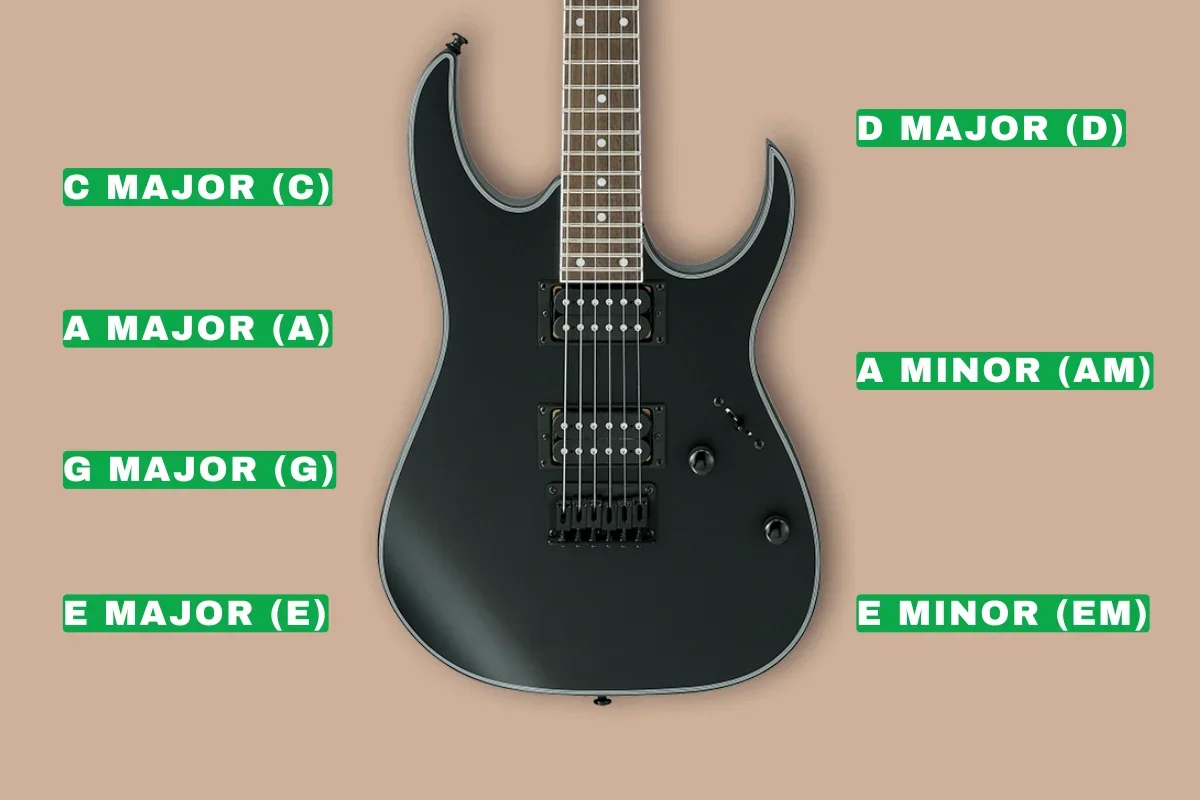Easy Guitar Open Chords Every Beginner Should Learn First
The guitar requires one to learn the basic chords in order to play the songs with confidence. These chords help you find the basis to play the chord clean and begin to play music right away. As a beginner, it is simple to practice the open chords (such as C Major, G Major, D Major, and E Minor) to start with.
Learning is important. A check of finger placement using a chord diagram will have your chords sounding clean and your fingers able to develop the strength and flexibility required. Mastering these fundamentals puts you in a position to major chord variations, barre chords, and the ability to play actual tunes you can play immediately.
What Are Open Chords?
Open chords are those that contain one or more open strings- strings played without depression. Guitar chords for beginners are the simplest to learn as they do not exercise your fingers and remain full-bodied even when your hands are not yet strong.
Before you jump into playing tricky guitar chords, learn to play the basic chords like the major shapes of guitar chords. Try a chord diagram to make sure you are in the right place with your fingers and the switch between chords. Start Query on the 2nd fret/ 3rd fret to get accustomed, and then accelerate progressively.
Open chords get you ready to play the chords in your songs with confidence. Mastering them first prepares the groundwork to barre chords, more complicated chords, and smoother chord transitions during practice sessions.
Essential Chords Every Beginner Should Know
When starting, focus on basic guitar chords that appear in most songs. These guitar chords for beginners are easy to play and help build confidence quickly.
C Major (C)
Place your ring finger on the 3rd fret of the 5th string, middle finger on the 2nd fret of the 4th string, and index finger on the 1st fret of the 2nd string.
Tip: Strum from the 5th string and avoid hitting the 6th string.
A Major (A)
Press the 2nd fret of the 2nd, 3rd, and 4th strings with your index, middle, and ring fingers.
Tip: Keep your fingers close to the frets for a clean sound.
G Major (G)
Place your middle finger on the 3rd fret of the 6th string, index finger on the 2nd fret of the 5th string, and ring finger on the 3rd fret of the 1st string.
Tip: Ensure each string rings clearly by slightly arching your fingers.
E Major (E)
Place your middle finger on the 2nd fret of the 5th string, ring finger on the 2nd fret of the 4th string, and index finger on the 1st fret of the 3rd string.
Tip: Strum all six strings for a full, bright sound.
D Major (D)
Index finger on the 2nd fret of the 3rd string, middle finger on the 2nd fret of the 1st string, and ring finger on the 3rd fret of the 2nd string.
Tip: Strum from the 4th string and mute the 5th and 6th strings.
A Minor (Am)
Index finger on the 1st fret of the 2nd string, middle finger on the 2nd fret of the 4th string, and ring finger on the 2nd fret of the 3rd string.
Tip: Strum from the 5th string, keeping your fingers relaxed.
E Minor (Em)
Middle finger on the 2nd fret of the 5th string and ring finger on the 2nd fret of the 4th string.
Tip: Strum all strings; this chord is easy to play and great for beginners.
How to Practice These Chords
Practice daily, even for 10–15 minutes.
There is no use having a long infrequent session as compared to short, consistent ones. Repeat practice helps beginners learn guitar chords fast. Gradually, you will see how the changing of your chords will start flowing better, and you will develop finger strength.
Focus on basic guitar chords and play each chord cleanly.
Make each of the strings sound clearly before proceeding with the rest of the chord. This focus develops precision and mastery with simple guitar chords. Do not go in a rush, as it strengthens the position of fingers and muscle memory.
Use chord diagrams for correct finger placement.t
Checking a. chord diagram ensures your fingers are on the correct frets and strings. This prevents mistakes like muted or buzzing notes. Following diagrams consistently speeds up learning and strengthens chord accuracy.
Start slowly to build muscle memory
Move deliberately between C Major, G Major, D Major, and other chords. Repeating these patterns trains your fingers to remember each shape. With practice, you’ll transition smoothly while playing songs confidently.
Incorporate short, frequent practice sessions.
Practicing in small bursts prevents hand fatigue and maintains focus. Frequent practice improves speed and precision gradually. It also makes learning to play the chord timing easier.
Try simple strumming patterns to improve rhythm.
Use up and down strokes along with a metronome to stay in tempo. Practicing rhythm helps you play the chords in real songs naturally. This develops coordination between your strumming hand and fretting hand.
Use the 2nd fret and 3rd fret chords to stretch your fingers.
Practicing these frets builds flexibility and finger strength. Start slowly to avoid discomfort. Mastering these frets prepares you for barre chords and more complex major chord shapes later.
Enroll in Zoom Twin Cities guitar lessons to get structured guidance and expert instruction.
Transitioning Between Chords
Practice smooth chord changes slowly.
Easy ones like C major to G major or D major to A minor. Play slowly to ensure that all the strings have been played on clearly without a muffled or buzzing sound, and then accelerate the speed of playing the chord to develop the self-confidence that comes with playing the chord.
Keep your fingers close to the strings when switching chords.
This minimizes redundant movement and speeds the switching between fundamental guitar chords. Avoiding maximum distance between fingers creates muscle memory so that you do not develop tension in your hand.
Anticipate the next chord before strumming.
Glance at the chord diagram or visualize finger placement while playing the current chord. Preparing your fingers ahead of time keeps the rhythm steady and ensures smooth transitions for guitar chords for beginners.
Practice common chord progressions repeatedly.
Practice chords, chords like CGAmF or GDEmC, to improve recall and timing. Repetition in these progressions enhances expertise; hence, one can comfortably perform a song with the chord.
Isolate tricky chord changes for focused practice.
Some switches, such as E Minor to D Major, can feel awkward at first. Spend extra time on these problem areas to improve precision and ensure your basic guitar chords sound clean in real songs.
Combine strumming with chord transitions.
Practice simple strumming patterns while switching chords to coordinate both hands. This builds rhythm and timing while letting you play the chord naturally in songs.
Use the 2nd fret and 3rd fret chords to strengthen fingers.
Practicing these frets enhances finger flexibility and builds strength for smoother transitions. This prepares you for barre chords and more complex major chord shapes in the future.
Common Beginner Mistakes to Avoid
Improper Finger Placement on Chords
Novice players have their fingers too far away from the frets or press down on several strings at a time. Use a chord diagram to verify the placement and that each of the strings has its voice ringing. Right positioning of the fingers will enable you to play the chords correctly, whether on the 2 nd or the 3rd fret, a nd gain confidence in simple guitar chords.
Strumming Too Fast or Unevenly
Rushing through guitar chords for beginners can make your songs sound messy. Start slow with controlled strumming patterns and gradually increase speed. Proper strumming improves rhythm and ensures each major chord or open chord sounds clean when you play the chord.
Not Practicing Chord Transitions
Many beginners focus on single chords without practicing changes between them. Repeatedly switching between C Major, G Major, D Major, and other basic guitar chords strengthens muscle memory. Smooth transitions make it easier to play the chord in songs and move across the 2nd fret and 3rd fret efficiently.
Tension in the Fretting Hand
Pressing too hard or keeping fingers rigid causes fatigue and slower learning. Relax your hand and use light pressure on major chord shapes to play longer without strain. Relaxed fingers help you play the chord clearly in all guitar chords for beginners.
Ignoring Open Strings
Beginners sometimes accidentally mute open strings in open chords. Check your chord diagram and make sure the open strings ring out. Correct open string technique improves the sound quality and helps you confidently play the chord across the 2nd fret and 3rd fret.
Skipping Short, Frequent Practice Sessions
Long, infrequent practice reduces retention and finger strength. Daily short sessions strengthen your hands and improve basic guitar chords mastery. Consistent practice ensures smooth transitions and better playing of the chord timing in real songs.
Next Steps in Your Guitar Journey
Explore Barre Chords
After mastering basic guitar chords, it’s time to try barre chords. These chords use one finger to press multiple strings, letting you play in different positions on the neck. Practicing barre chords builds finger strength and helps you play the chord cleanly across the 2nd and 3rd frets.
Play Songs You Can Play
Start applying your skills to songs you can play using the chords you already know. Begin with simple C Major, G Major, D Major, and E Minor progressions to gain confidence. Playing real songs reinforces strumming patterns, timing, and helps you consistently use the frets in context.
Learn Other Instruments
Adding bass guitar lessons, drum lessons, or piano lessons strengthens your overall music sense. Understanding rhythm and melody on other instruments improves timing and complements your guitar practice. Exploring multiple instruments also helps beginners connect theory with practice in guitar chords for beginners.



